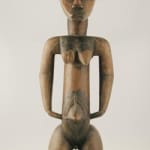Bete Wooden Sculpture of a Woman, 20th Century CE
Wood
7.5 x 23.5
PF.3196 (LSO)
Further images
This powerful and geometric-looking sculpture of a woman was made by the Bete group of the Ivory Coast. It is very angular, with sectorial limbs which emphasise their complex construction....
This powerful and geometric-looking sculpture of a woman was made by the Bete group of the Ivory Coast. It is very angular, with sectorial limbs which emphasise their complex construction. The torso is elongated, the arms long and the legs very short. The thigh is flexed at the hip. The breasts are strongly marked and project straight from the shoulders. The neck is tall and columnar, supporting a large, oval head with a face cut into the smooth frontal profile with a T-bar nose and nugatory mouth. The navel is marked with diamond-shaped scarring. The wood is unpainted but patinated with a nice glossy finish.
The Bete are a little-studied Ivory Coast group with strong cultural and artistic links to the Dan, the We (Gwere) and the Guro, among others. There are 93 distinct groups within the Bete polity. They are united only in that they subsistence farm to survive, but base most of their social and cultural lives around the hunt. Social control was exercised by the leading member of individual lineages (of which there were several in each village) who exercised judicial and financial power within the community. Spiritual authority was wielded with an array of paraphernalia, notably including the “gre” mask, a horned and decorated creation (originating with the We) designed to instil terror in the onlooker, to quell social unrest, and to be worn when meting out justice after conflict.
Statuary is rare, and is based around feminine iconography that refers to the mythical mother figure. There is no recognised liturgical function, although some early reports indicate that a pair of figures was often placed under a rain shelter in a village in order to represent the founders. This evocation of a primeval couple has widespread resonance in African culture.
The outstanding glossy patina seems to argue against exposure to the elements as has been described by early explorers. It is more likely that this figure stood in a central and presumably magico-religiously important site within the village, where it performed some valuable social function that was probably linked with fertility. This is an outstanding piece of African art.
The Bete are a little-studied Ivory Coast group with strong cultural and artistic links to the Dan, the We (Gwere) and the Guro, among others. There are 93 distinct groups within the Bete polity. They are united only in that they subsistence farm to survive, but base most of their social and cultural lives around the hunt. Social control was exercised by the leading member of individual lineages (of which there were several in each village) who exercised judicial and financial power within the community. Spiritual authority was wielded with an array of paraphernalia, notably including the “gre” mask, a horned and decorated creation (originating with the We) designed to instil terror in the onlooker, to quell social unrest, and to be worn when meting out justice after conflict.
Statuary is rare, and is based around feminine iconography that refers to the mythical mother figure. There is no recognised liturgical function, although some early reports indicate that a pair of figures was often placed under a rain shelter in a village in order to represent the founders. This evocation of a primeval couple has widespread resonance in African culture.
The outstanding glossy patina seems to argue against exposure to the elements as has been described by early explorers. It is more likely that this figure stood in a central and presumably magico-religiously important site within the village, where it performed some valuable social function that was probably linked with fertility. This is an outstanding piece of African art.







